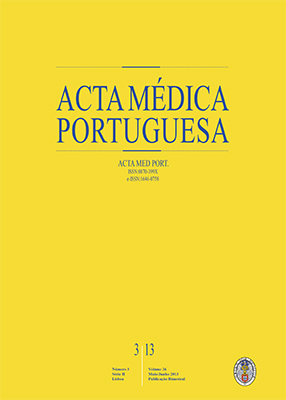Clinical Anatomy: Anthropometry for Nutritional Assessment of 367 Adults who Underwent Endoscopic Gastrostomy
DOI:
https://doi.org/10.20344/amp.4247Abstract
Introduction: Patients suffering from long standing dysphagia need tube feeding through gastrostomy. Nutritional assessment of these patients is challenging and must be supported on objective data, including anthropometric evaluation.Aim: The aim of this study was the evaluation of the usefulness of anthropometry for identifying and grading malnutrition, as part of the initial assessment of patients that underwent endoscopic gastrostomy.
Material and Methods: From the files of consecutive adults underwent gastrostomy we selected patients with anthropometric data obtained before the procedure: Body Mass Index, Mid Upper Arm Circumference, Triceps Skinfold Thickness and Mid Arm Muscle Circumference. Nutritional status was classified according with World Health Organization criteria for Body Mass Index, and for Mid Upper Arm Circumference, Triceps Skinfold Thickness and Mid Arm Muscle Circumference using comparison with Frisancho reference-tables.
Results: Were selected 367 patients (median of ages: 74.1 years): neurological disease: 172; head and neck cancer: 176; other diseases: 19. Body Mass Index identified 136 underweight and 231 eutrophic or overweight patients. Mid Upper Arm Circumference identified 310 malnourished and 57 eutrophic or overweight patients. Triceps Skinfold Thickness identified 301 malnourished and 66 eutrophic or overweight patients. Mid Arm Muscle Circumference identified 269 malnourished, 97 eutrophic and one with MAMC above normal.
Discussion and Conclusions: Anthropometry identified the malnourished endoscopic gastrostomy-patients, contributed for malnutrition grading and demonstrated the impact on muscle and fat reserves. Mid Upper Arm Circumference, Triceps Skinfold Thickness and Mid Arm Muscle Circumference identified malnutrition in nearly 80% of the patients, most clearly with fat tissue wasting than muscle. Easily accessible e inexpensive, anthropometry allowed personalized nutritional therapy. Anthropometry must be recognized as a fundamental tool for enteral feeding teams.
Downloads
Downloads
Published
How to Cite
Issue
Section
License
All the articles published in the AMP are open access and comply with the requirements of funding agencies or academic institutions. The AMP is governed by the terms of the Creative Commons ‘Attribution – Non-Commercial Use - (CC-BY-NC)’ license, regarding the use by third parties.
It is the author’s responsibility to obtain approval for the reproduction of figures, tables, etc. from other publications.
Upon acceptance of an article for publication, the authors will be asked to complete the ICMJE “Copyright Liability and Copyright Sharing Statement “(http://www.actamedicaportuguesa.com/info/AMP-NormasPublicacao.pdf) and the “Declaration of Potential Conflicts of Interest” (http:// www.icmje.org/conflicts-of-interest). An e-mail will be sent to the corresponding author to acknowledge receipt of the manuscript.
After publication, the authors are authorised to make their articles available in repositories of their institutions of origin, as long as they always mention where they were published and according to the Creative Commons license.









